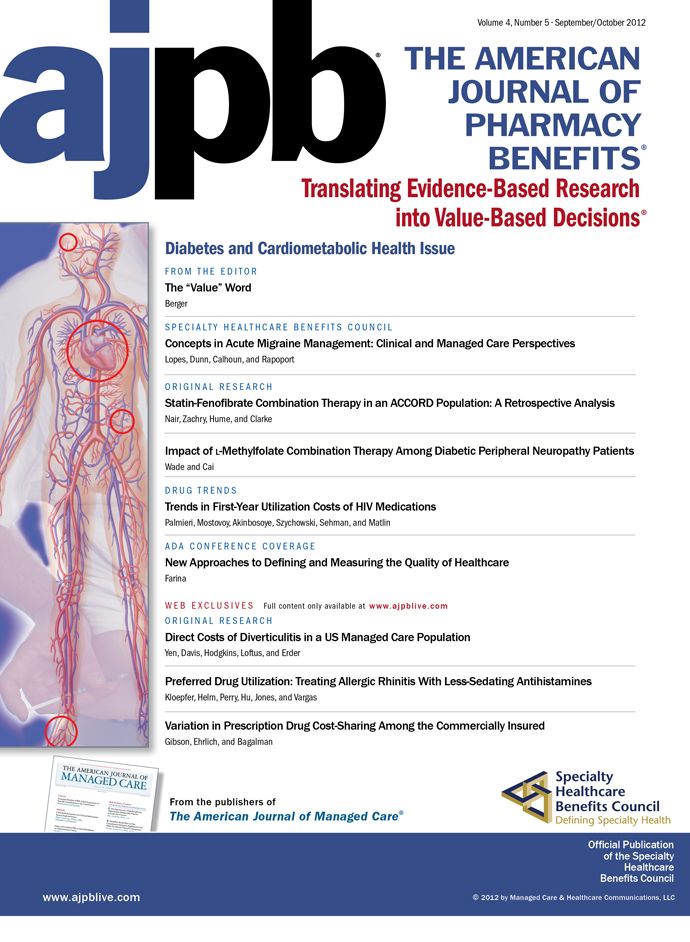Publication
Article
AJPB® Translating Evidence-Based Research Into Value-Based Decisions®
Trends in the 2012 Eisai Oncology Digest: Insurance and Cost Obstacles in Cancer Treatment
Author(s):
Results from Eisai Inc's online national survey of cancer patients, published in the 2012 Eisai Oncology Digest, highlight financial concerns of cancer treatment and their impact on treatment adherence.
Introduction
This is the final article in a series of 3 that highlights results from a national survey of patients with cancer.1 The first 2 articles discussed patients’ perceptions about their treatment2 and how medical staff communicated information about their disease and treatment plan.3 This article focuses on the financial concerns of cancer treatment.
The survey involved 418 patients who within the past 5 years had, or still have, cancer. All patients were aware of their health insurance/prescription drug coverage status and most patients (97%) stated that their prescription drugs were covered by health insurance (41% had health insurance through their employer; 31% had health insurance through a state or federal agency).
Impact of Cost or Insurance Coverage on Cancer Treatment
A total of 90% of respondents indicated that they did not have any cost or insurance coverage rules preventing them from taking prescribed medications, receiving treatments ordered for them, or utilizing their preferred physicians and hospital (
Figure 1
). Overall, these results showed improvements from the 2010 survey results.4
Medication Coverage
In most cases, medication was covered by the patient’s health insurance plan; however, 17% of patients indicated that a prescription ordered by the doctor was not filled by their pharmacist due to insurance coverage reasons. This is a lower percentage than that observed in the 2010 survey (25%).4 In most cases, patients were able to find a way to obtain their medication or a similar medication (
Table 1
). Among patients receiving intravenous chemotherapy, 40% had to pay some form of a drug copay (Figure 2).
The Medicare Donut Hole
Among 98 patients using the Medicare Part D drug plan, 15% stated they had reached the donut hole (compared with 30% of Part D respondents from the 2010 survey who stated they reached the donut hole).4 Of those in the donut hole, 86% continued taking their medications and paid out of pocket (
Table 2
). The remaining patients stopped taking their medications or switched to generic or lower-cost brand medications and paid for them.
Treatment Adherence
Survey results indicated that most patients took multiple medications, with 54% stating that they took 1 to 3 prescriptions, 24% that they took 4 to 5, and 22% that they took 6 or more. Although most patients took their medication as prescribed,
• 42 (10%) patients stopped taking their medication
• 30 (7%) patients did not fi ll their original prescription
• 39 (9%) patients did not refi ll their medication.
The top 3 reasons for nonadherence were side effects, a perceived lack of efficacy, and the cost of medication (
Figure 3
). Among patients who stopped taking or did not refi ll their medication, one-third to one-half indicated that additional counseling would have corrected their behavior (
Table 3
).
Conclusion
In most cases, patients with health insurance were able to obtain their medication. Compared with 2010 survey results, patients encountered fewer obstacles in receiving treatment and using preferred doctors and hospitals. This may be due, in part, to certain provisions of the Patient Protection and Affordable Care Act being implemented in 2011, such as the 50% discount on branded drugs for Medicare Part D enrollees as they enter the donut hole, or the requirement that employers eliminate caps on annual or lifetime coverage.







